We published an update on this Long Idea on July 28, 2021. A copy of the associated Earnings Update report is here.
Check out this week’s Danger Zone Interview with Chuck Jaffe of Money Life.
COVID-19 has disrupted industries all across the globe, perhaps none more than the Healthcare industry. Hospitals incurred costly preparations for COVID-19 patients and big hits to revenue from reductions in nonurgent care patients. Investors who cannot see past the temporary disruption to HCA Healthcare Inc’s (HCA: $98/share) operations are in the Danger Zone. We think there’s great value in this Long Idea.
We previously made HCA Healthcare a Long Idea in December 2018. Since then, the stock has underperformed the S&P 500 (down 26% vs. S&P up 19%). Despite the stock’s underperformance, the firm has increased its profitability, and the stock is even more attractive.
HCA Healthcare’s History of Profit Growth
HCA Healthcare has a strong history of profit growth. Over the past five years, HCA has grown revenue by 7% compounded annually and core earnings[1] by 11% compounded annually, per Figure 1. Longer term, HCA Healthcare has grown core earnings by 16% compounded annually since 2007. The firm increased its core earnings margin from 2% in 2007 to 7% in the trailing-twelve-month period (TTM).
Figure 1: Core Earnings & Revenue Growth Over the Past Decade
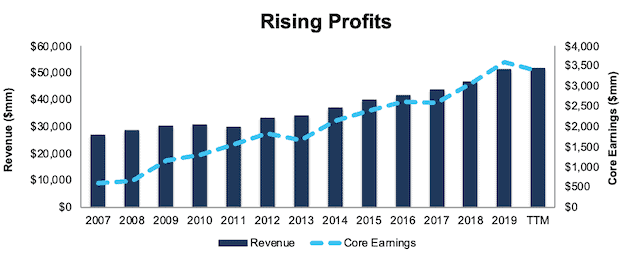
Sources: New Constructs, LLC and company filings.
HCA Healthcare’s rising profitability helps the business generate significant free cash flow (FCF). The company generated positive FCF in each of the past 12 years and a cumulative $14.6 billion (44% of market cap) in FCF over the past five years. HCA Healthcare’s $3.5 billion in FCF over the TTM period equates to a 5% FCF yield, which is significantly higher than the Healthcare sector average of -1%.
Ample Liquidity to Survive the Downturn
While COVID-19 has disrupted HCA Healthcare’s patient volume in the short term, the firm’s available liquidity positions it to weather the economic downturn. At the end of 1Q20, the firm had ~$3.8 billion available under its current credit facilities and $731 million in cash and equivalents. Additionally, by April, the firm had received nearly all of the $4 billion of accelerated payments provided by the CARES Act. While the firm will repay this money over an eight month period beginning in August 2020, it provides a stop gap to help navigate the present reduction in revenue.
In addition to having a strong cash balance, the firm has implemented cost reduction initiatives, suspended its share repurchase and dividend programs, reduced planned projects, and reduced planned capital expenditures for 2020 from ~$4.1 billion to ~$2.9 billion. The firm spent $853 million on capex in1Q20.
In a worst-case scenario, where HCA Healthcare generates no revenue, the firm could operate for over three months with its available liquidity before needing additional capital. This scenario assumes HCA Healthcare maintains spending at current levels, including Salaries and Benefits expenses and interest expenses ($6.5 billion in 1Q20) and an expected monthly capex of $222 million.
However, it’s highly unlikely that HCA Healthcare’s revenue would go to zero given its diverse geographical presence and the essential nature of its operations in the current environment. The firm generated $12.9 billion in revenue in 1Q20, which included the first few weeks of the healthcare industry’s response to the COVID-19 pandemic. Additionally, all of HCA Healthcare’s hospital beds are in locations where state and national authorities are permitting at least some elective procedures.
If we assume the firm’s revenue were to fall 50% from 1Q20 levels, the firm could operate for over 8 months without needing to raise additional capital.
Superior Profitability Helps Maintain Patient Care During the Crisis and Grow in the Recovery
COVID-driven disruptions to the hospital industry may drive financially weaker operators out of business. HCA Healthcare’s profitability was superior to its competitors before the crisis, and the firm is well-positioned to grow profits when the economy recovers.
Per Figure 2, HCA Healthcare’s net operating profit after-tax (NOPAT) margin, despite small fluctuations, has consistently been ~11% from 2015 to TTM. Over the same time, the market-cap-weighted average of HCA Healthcare’s peer group has only slightly improved from 8% in 2015 to 9% TTM, well below HCA Healthcare. This peer group consists of the six other hospital operators: Tenet Healthcare Corp (THC), Community Health Systems, Inc. (CYH), Universal Health Services, Inc. (UHS), Select Medical Holdings Corp (SEM), Encompass Health Corp (EHC), and Quorum Health Corporation (QHCCQ).
Figure 2: NOPAT Margin Vs. Peers
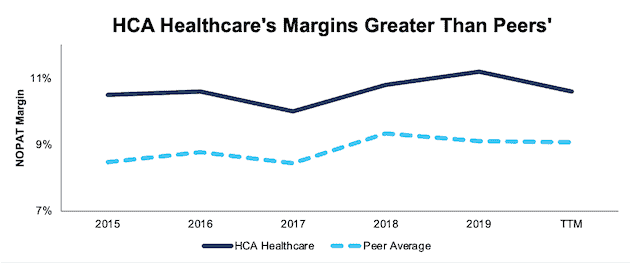
Sources: New Constructs, LLC and company filings.
HCA Healthcare’s invested capital turns, a measure of balance sheet efficiency, have slightly fallen from 1.5 in 2015 to 1.4 TTM, per Figure 3. On the other hand, the peer group’s market-cap-weighted average invested capital turns have remained unchanged over the same time at a much lower 0.9.
Figure 3: Invested Capital Turns Vs. Peers
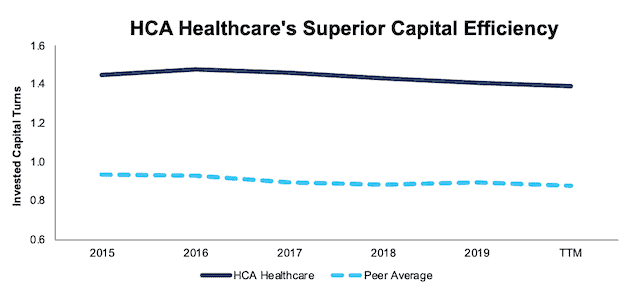
Sources: New Constructs, LLC and company filings.
The combination of higher margins and superior invested capital turns drive HCA Healthcare’s leading return on invested capital (ROIC). Per Figure 4, HCA Healthcare’s ROIC has remained relatively unchanged at 15% from 2015 to TTM while the market-cap- weighted average of peers’ ROIC has also remained unchanged over the same time at a much lower 8%.
Figure 4: ROIC vs. Peers
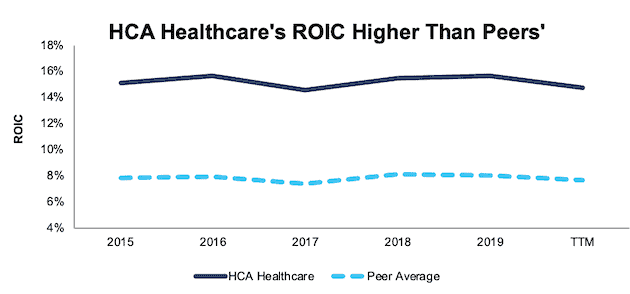
Sources: New Constructs, LLC and company filings.
Unless you believe that there will be no need for treatment of nonurgent care patients in a post-COVID-19 world, it’s hard to argue against HCA Healthcare’s ability to survive. And, if it survives, it’s hard to argue that the firm’s superior profitability before the crisis will not translate into growth opportunities and profit growth after the crisis.
HCA Healthcare’s Growing Market Share
HCA Healthcare’s superior profitability has positioned the firm to grow its presence across the country and increase its overall market share. Figure 5 shows that HCA Healthcare’s domestic revenue represented 3.4% of total national hospital care expenditures in 2011 and steadily increased to 4.0% in 2019.
Figure 5: HCA’s Growing Share of National Hospital Care Expenditures
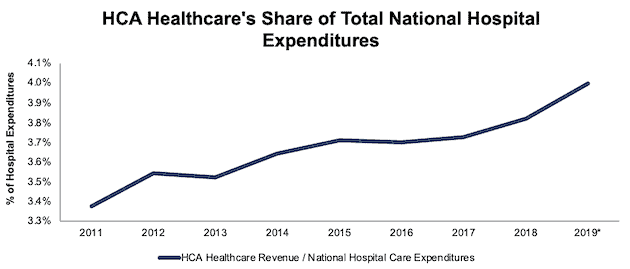
Sources: New Constructs, LLC and CMS.gov
*2019 value based on CMS projections
The COVID-19 pandemic is having an adverse impact on HCA Healthcare’s operations in the short term, as patients delay certain elective procedures. However, we believe HCA Healthcare is well-positioned, as a leading healthcare provider, to continue to provide for patients, address nonurgent medical needs, and even increase its share of healthcare spending once the pandemic is behind us.
Healthcare Is Changing – and HCA Healthcare Is Adapting
The rise of urgent care centers, ambulatory surgery centers (ASCs), and imaging centers over the past several years pose a direct threat to traditional hospital services. To address that threat, HCA Healthcare is expanding its specialized health services as the firm is more than just a system of traditional hospitals.
In addition to acute care hospitals, HCA Healthcare operates freestanding surgery centers, freestanding emergency care facilities, urgent care facilities, walk-in clinics, diagnostic centers, and rehabilitation facilities. In total, HCA not only operates 184 hospitals, but also ~2,000 sites of care.
Since purchasing CareNow, an urgent care company in 2014, HCA has grown the business from 24 locations to the 160 in 2020, or more than 46% compounded annually. For comparison, there were 6,300 urgent care centers in the U.S. in 2013. By 2018, that number had increased by 8% compounded annually to 8,774 according to the Urgent Care Association.
Even in the midst of the increase of urgent care competition, HCA Healthcare’s emergency room visits have grown from 7.5 million in 2014 to 9.2 million in 2019, or 4% compounded annually. HCA Healthcare has grown both its traditional emergency department and its newer urgent care center service simultaneously.
ASCs, which typically provide lower cost outpatient surgeries, represent another threat to traditional hospitals, one that HCA Healthcare is also addressing. HCA Healthcare has grown its ASCs from 116 in 2011 to more than 130 today, or 1% compounded annually. This growth has kept pace with the total Medicare certified ASCs, which also grew by 1% compounded annually from 5,217 in 2011 to 5,700 in 2018.
Even with increased outpatient competition from ASCs, HCA Healthcare grew its outpatient surgeries from 892 thousand in 2014 to one million in 2019, or 3% compounded annually.
The take away is that HCA has the capital and expertise to grow and be a key player in the ASC business.
Telehealth Makes HCA Healthcare More Efficient
The recent events of the COVID-19 pandemic have highlighted the importance of telethealth to healthcare providers. In fact, the telethealth market is expected to grow by 15% compounded annually from 2020 to 2027.
While telethealth may appear to be a threat to some traditional healthcare providers, hospitals can utilize the technology to increase efficiency by reducing waiting times and lowering treatment costs. Though HCA Healthcare already had a service line for telehealth primarily used for diagnostic and clinical support to reduce the time from consultation to intervention, the firm has been ramping up its telehealth services during the pandemic by utilizing the technology in outpatient clinics, inpatient treatment, urgent care, and patient and employee monitoring.
The firm has also broadened its reach by deploying telehealth in all of its urgent care facilities. Doing so allows patients the ability to consult with a physician without the fear of potential exposure to COVID-19 while reducing the risk of exposure to those who require in-person treatment.
HCA Healthcare has also discovered that it can more efficiently complete specialist visits that do not require a physical exam by using its telehealth endpoints. This again reduces exposure to COVID-19 to all patients and doctors, which helps to make healthcare facilities safer for all.
While telethealth may be beneficial for routine and nonurgent consultations, it cannot eliminate the need to visit doctors for physical procedures. Emergency room care and surgeries will continue to be needed no matter how a patient is initially diagnosed.
Demographics Drive Growth
Increased population leads to organic growth in hospital services and the total population of the United States is expected to grow by 0.9% compounded annually over the next decade. HCA Healthcare, based on the location of its hospitals around the country, could experience growth that exceeds the national average.
54% of HCA Healthcare’s total U.S. hospital beds are in Texas and Florida, whose populations are expected to grow by 1.6% compounded annually and 1.5% compounded annually, respectively through 2030. Furthermore, 74% of HCA Healthcare operated hospital beds in 2019 were in states whose populations are expected to outpace the general U.S. growth over the next decade. Figure 6 shows that the states where HCA Healthcare operates are expected to grow at 1.3% compounded annually.
Figure 6: HCA Healthcare’s Markets Are Expected to Grow Faster Than the U.S. Population

Sources: New Constructs, LLC, company filings, and Demographics Research Group.
Not only is the U.S. population growing, but it is also aging. The population of those aged 65 and older is expected to increase from ~56 million today to ~73 million in 2030. 2030 marks the first year where all baby boomers will be 65 or older. While this group represented 16% of the U.S. population in 2016, they represented 36% of the total U.S. health spending in that year. In 2010, per capita spending for those 65 and older was more than three times that of those aged 19 to 64. An increase in the age of the population will translate into increased health spending.
Leveraging Its Size to Grow
Being one of the largest healthcare firms in the nation, HCA Healthcare is able to leverage superior scale over smaller operators. The firm’s centralized management enables HCA Healthcare to streamline its operational complexities and reduce its administrative costs. It also operates HealthTrust, a group purchasing organization (GPO), to gain supply cost advantages.
The firm’s expertise in revenue cycle management, health care group purchasing, supply chain management, and staffing functions led it to invest in Parallon, a subsidiary, that partners with healthcare providers to more efficiently manage their operations. Not only has the firm leveraged its operational excellence into increased efficiency for itself, but it has developed an entirely new revenue stream in the process.
Quality Matters, Not Just Quantity
While HCA Healthcare has over 49,000 licensed beds, the firm is able to provide high-quality care. 81% of its U.S. hospitals received a Hospital Safety Grade of A or B from The Leapfrog Group in the fall of 2019. For comparison, just 57% of non-HCA Healthcare U.S. hospitals received a Hospital Safety Grade of A or B.
According to the American Heart Association and the American Stroke Association, treatment centers should attempt to treat stroke patients with medication in less than 60 minutes from arrival. HCA Healthcare boasts an average time of 42 minutes.
Another example of quality care provided by the firm is its research investment in its standardized protocols for mothers during and after pregnancy. HCA Hospitals claims a mortality rate of 4.3 per 100,000 deliveries. For comparison, the CDC reports a rate of 17.4 deaths per 100,000 live births in the U.S. in 2018.
The firm’s size and centralized organization not only reduce costs, but allow the firm to identify and scale best practices across the organization to provide a higher-level of care to its patients.
HCA Is Undervalued
After falling 34% year-to-date (YTD) to $98/share, HCA now trades significantly below its economic book value, or no-growth value, and at its cheapest price-to-economic book value (PEBV) ratio (0.4) since 2016. This ratio means the market expects HCA Healthcare’s NOPAT to permanently decline by 60%. This expectation seems overly pessimistic over the long term. For reference, HCA Healthcare has grown NOPAT by 6% compounded annually since 2007.
HCA Healthcare’s current economic book value is $235/share – a 140% upside.
Figure 7: Stock Price vs. Economic Book Value (EBV)
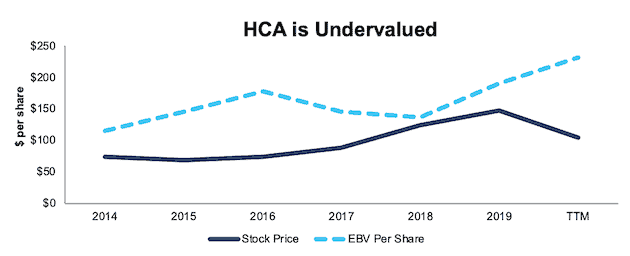
Sources: New Constructs, LLC and company filings.
HCA’s Current Price Implies No Economic Recovery
Despite consensus estimates for year-over-year (YoY) revenue growth in 2021 and 2022, HCA is priced as if the COVID-driven economic decline will permanently depress its profits. Below, we use our reverse DCF model to quantify the cash flow expectations baked into HCA Healthcare’s current stock price. Then, we analyze the implied value of the stock based on different assumptions about COVID-19’s impact on the economy and HCA Healthcare’s future growth in cash flows.
Scenario 1: Using historical revenue declines, historical margins, and average historical GDP growth rates, we can model the worst-case scenario already implied by HCA Healthcare’s current stock price. In this scenario, we assume:
- NOPAT margins fall to 9% (company low in 2008, compared to 11% TTM) in 2020-2022 and increase to 10% (average since 2007) in 2023 and each year thereafter
- Revenue falls 45% (greater than the revenue decline that ~80% of surveyed hospital and health system executives expect for 2020 and consensus estimates of -5%) in 2020 and does not grow in 2021 or 2022 (vs consensus estimates of 12% and 4%)
- Sales begin growing again in 2023, but only at 3.5% a year, which is the average global GDP growth rate since 1961
In this scenario, where HCA Healthcare’s NOPAT declines 5% compounded annually over the next nine years (including a 56% YoY drop in 2020), the stock is worth $102/share today – nearly equal to the current stock price. See the math behind this reverse DCF scenario.
For reference, the largest YoY change in HCA Healthcare’s NOPAT occurred in 2008, when NOPAT declined 8% before growing 15% YoY in 2009.
Figure 8 compares the firm’s implied future NOPAT to its historical NOPAT in this scenario. This worst-case scenario implies HCA Healthcare’s NOPAT nine years from now will be 37% below its 2019 NOPAT. In other words, this scenario implies that nine years after the COVID-19 pandemic, HCA Healthcare’s profits will have only recovered to 7% below 2014 levels. In any scenario better than this one, HCA holds significant upside potential, as we’ll show below.
Figure 8: Current Valuation Implies Severe, Long-Term Decline in Profits: Scenario 1
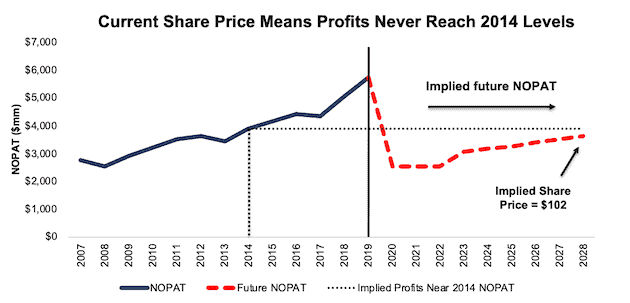
Sources: New Constructs, LLC and company filings.
Scenario 2: Long-term View Could Be Very Profitable
If we assume, as does the International Monetary Fund (IMF) and nearly every economist in the world, that the global economy rebounds and returns to growth starting in 2021, HCA is undervalued.
In this scenario, we assume:
- NOPAT margins fall to 9% (company low in 2008, compared to 11% TTM) in 2020 and increase to 10% (average since 2007) in 2021 and each year thereafter
- Revenue falls 35% (greater than the revenue decline that ~80% of surveyed hospital and health system executives expect for 2020 and consensus estimates of -5%) in 2020 and grows at consensus estimates of 12% in 2021 and 4% in 2022
- Sales grow at 3.5% in 2023 and each year thereafter, which is the average global GDP growth rate since 1961
In this scenario, HCA Healthcare’s NOPAT falls by 1% compounded annually over the next decade (including a 48% YoY drop in 2020) and the stock is worth $195/share today – a 99% upside to the current price. See the math behind this reverse DCF scenario.
For comparison, HCA Healthcare has grown NOPAT by 8% compounded annually over the past five years and 7% compounded annually over the past decade. It’s not often investors get the opportunity to buy an industry leader at such a discounted price.
Figure 9 compares the firm’s implied future NOPAT to its historical NOPAT in scenario 2. This moderate scenario implies that a decade from now, HCA Healthcare’s NOPAT will only be 2% above 2018 levels and 10% below 2019 levels. If profits return to these levels in less than 10 years, HCA has even more upside potential.
Figure 9: Implied Profits Assuming Moderate Recovery: Scenario 2
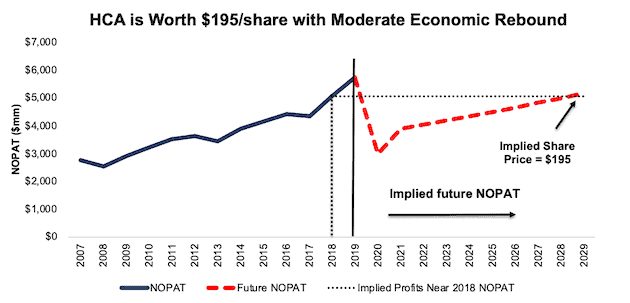
Sources: New Constructs, LLC and company filings.
Sustainable Competitive Advantages Will Drive Shareholder Value Creation
Here’s a summary of why we think the moat around HCA Healthcare’s business will enable it to continue to generate higher NOPAT than the current market valuation implies. The following competitive advantages help HCA Healthcare survive the downturn and return to growth as the economy grows again:
- Strong balance sheet to survive the economic dip
- HCA Healthcare’s presence in growing regions of the U.S.
- Economies of scale that drive superior efficiency
- Superior profitability to its peer group
What Noise Traders Miss with HCA Healthcare
These days, fewer investors focus on finding quality capital allocators with shareholder friendly corporate governance. Instead, due to the proliferation of noise traders, the focus is on short-term technical trading trends while high-quality fundamental research is overlooked. Here’s a quick summary of what noise traders are missing:
- Strong history of core earnings growth
- Increased medical expenditures from the aging population of the U.S.
- The firm’s growing market share
- Valuation implies nonurgent hospital care never recovers
The Yield Is on Hold but Should Come Back
HCA Healthcare suspended its dividend program and in its 1Q20 earnings call noted, “We expect to evaluate resumption of the dividend program at a future date.”
Before the suspension, the firm paid a dividend in the last two years. Over that time the firm generated far more in in free cash flow ($5.5 billion) than it paid out in dividends ($1.0 billion), or an average $2.3 billion surplus each year. Its last quarterly dividend, when annualized, equaled $1.60/share and provided a 1.8% yield.
Firms with cash flows greater than dividend payments have a higher likelihood to maintain and grow dividends. While HCA Healthcare suspended its dividend in the short term, investors buying at current prices should get a nice yield with upside potential as the firm reinstates the dividend over the long term.
Historically, HCA Healthcare has also returned capital to its shareholders through share repurchases. HCA Healthcare has repurchased $10.2 billion (31% of current market cap) since 2015.
Prior to suspending its repurchase program, the firm had $2.8 billion (9% of current market cap) remaining for future repurchases under its current authorization. Should the firm start repurchasing shares once the economy stabilizes, or even returns to growth, it would provide additional yield for investors.
A Consensus Beat or Signs of Recovery Could Send Shares Higher
According to Zacks, consensus estimates at the end of January pegged HCA Healthcare’s 2020 EPS at $11.68/share. Jump forward to June 19, and consensus estimates for HCA Healthcare’s 2020 EPS have fallen to $4.89/share. 2021 estimates follow a similar trend. At the end of January, 2021 EPS consensus was $12.81/share, which has since fallen to $10.65/share.
Though the COVID-19 pandemic has reduced healthcare demand, these lowered expectations provide a great opportunity for a strong operator, such as HCA Healthcare, to beat consensus, if not this quarter, then maybe the next. Though our current Earnings Distortion Score, which is a short-term indicator of the likelihood to beat or miss expectations, for HCA Healthcare is “In-Line”, lowered expectations moving forward could make it much easier to beat earnings.
The firm beat EPS estimates in seven of the past 10 quarters, and doing so again, in the midst of such market turmoil, could send shares higher.
Lastly, any signs of a recovery in the global economy would send shares higher.
Executive Compensation Could Be Improved but Raises No Red Flags
No matter the macro environment, investors should look for companies with executive compensation plans that directly align executives’ interests with shareholders’ interests. Quality corporate governance holds executives accountable to shareholders by incentivizing them to allocate capital prudently.
In 2019, 82% to 92% of executive compensation was performance based. 80% of the firm’s senior officers’ annual incentive awards were based on achieving a targeted level of EBITDA. The remaining 20% was tied to patient care and quality benchmarks. Vesting for performance share units (PSUs) issued in 2019 is based on achievement of a three-year earnings per share goal. The remaining 50% of the firm’s long-term incentive was in the form of stock appreciation rights which reward executives for future growth in price of the firm’s shares.
We would prefer the firm use ROIC improvement when determining executive compensation, as there is a strong correlation between improving ROIC and increasing shareholder value. Having accurate values for NOPAT and invested capital ensures investors have an apples-to-apples metric for measuring corporate performance and holds management accountable for every dollar invested into the company.
Despite not using ROIC when measuring performance, and instead focusing on a flawed metric in EBITDA, HCA Healthcare’s compensation plan has not compensated executives while destroying shareholder value. HCA Healthcare has grown economic earnings by 7% compounded annually over the past five years and 6% compounded annually over the past decade.
Insider Trading and Short Interest Trends
Over the past twelve months, insiders have bought a total of 249 thousand shares and sold 566 thousand shares for a net effect of 323 thousand shares sold. These sales represent less than 1% of shares outstanding.
There are currently 3.9 million shares sold short, which equates to 1% of shares outstanding and just over one day to cover. Short interest is down 14% from the prior month. The low and declining short interest indicates few investors have an appetite to bet against this best-in-class performer.
Critical Details Found in Financial Filings by Our Robo-Analyst Technology
As investors focus more on fundamental research, research automation technology is needed to analyze all the critical financial details in financial filings as shown in the Harvard Business School and MIT Sloan paper, "Core Earnings: New Data and Evidence”.
Below are specifics on the adjustments we make based on Robo-Analyst findings in HCA Healthcare’s 2019 10-K:
Income Statement: we made $3.3 billion of adjustments, with a net effect of removing $2.2 billion in non-operating expenses (4% of revenue). You can see all the adjustments made to HCA Healthcare’s income statement here.
Balance Sheet: we made $4.5 billion of adjustments to calculate invested capital with a net decrease of $1.1 billion. One of the largest adjustments was $1.8 billion in deferred tax assets. This adjustment represented 5% of reported net assets. You can see all the adjustments made to HCA Healthcare’s balance sheet here.
Valuation: we made $43.0 billion of adjustments with a net effect of decreasing shareholder value by $43.0 billion. There were no adjustments that increased shareholder value. Apart from $40.2 billion in total debt, the most notable adjustment to shareholder value was $2.3 billion in minority interests. This adjustment represents 7% of HCA Healthcare’s market cap. See all adjustments to HCA Healthcare’s valuation here.
Attractive Funds That Hold HCA
The following funds receive our Attractive-or-better rating and allocate significantly to HCA:
- U.S. Global Investors All American Equity Fund (GBTFX) – 3.7% allocation and Attractive rating
- Frontier MFG Global Sustainable Fund (FMSGX) – 3.6% allocation and Attractive rating
- Sterling Capital Mid Value Fund (OVEIX) – 3.1% allocation and Attractive rating
- Frontier MFG Global Plus Fund (FMPSX) – 3.1% allocation and Attractive rating
- Frontier MFG Global Equity Fund (FMGEX) – 3.1% and Attractive rating
- First Trust Dorsey Wright Momentum & Value ETF (DVLU) – 2.9% and Very Attractive rating
- Neuberger Berman Multi Cap Opportunity Fund (NMUCX) – 2.5% and Attractive rating
This article originally published on June 22, 2020.
Disclosure: David Trainer, Kyle Guske II, and Matt Shuler receive no compensation to write about any specific stock, style, or theme.
Follow us on Twitter, Facebook, LinkedIn, and StockTwits for real-time alerts on all our research.
[1] Our core earnings are a superior measure of profits, as demonstrated in Core Earnings: New Data & Evidence a paper by professors at Harvard Business School (HBS) & MIT Sloan. The paper empirically shows that our data is superior to “Operating Income After Depreciation” and “Income Before Special Items” from Compustat, owned by S&P Global (SPGI).
